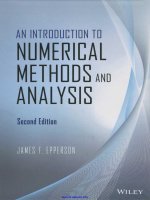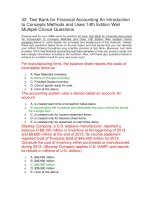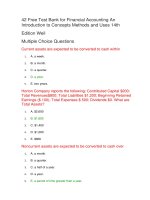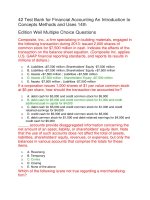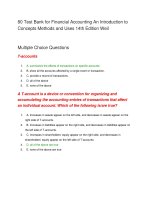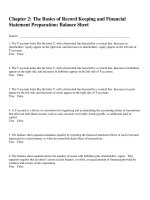Solution manual for managerial accounting an introduction to concepts methods and uses 11th edition by maher
Bạn đang xem bản rút gọn của tài liệu. Xem và tải ngay bản đầy đủ của tài liệu tại đây (406.56 KB, 36 trang )
CHAPTER 2
MEASURING PRODUCT COSTS
Questions, Exercises, Problems, and Cases: Answers and Solutions
2.1
See text or glossary at the end of the book.
2.2
Under a job-costing system, costs are accumulated by job. Thus, allocation
of these "costs" to output is relatively simple since the product is a welldefined, specific customer order. Under process costing, costs are
accumulated by department or production processes. Costs are then
spread evenly over the units produced.
2.3
Service organizations do not have a tangible "good." Therefore, there is no
tangible item which would qualify as an inventory item. All of the costs of
service personnel are considered expired as incurred. The organization's
product—service—is provided in the period in which service labor costs are
incurred.
2.4
An operation is a standardized method of making a product that is
repeatedly performed.
2.5
Operation costing has characteristics of both job costing and process
costing, so it is called a “hybrid” of these two.
2.6
Beginning Balance + Transfers In = Transfers Out + Ending Balance.
2.7
Assigning costs to the wrong jobs gives misinformation about the costs of
jobs. This misinformation affects the evaluation of the performance of job
supervisors. It affects job pricing if the job is partially or totally cost-plus
pricing. Managers use cost information about past jobs to estimate the
costs, and therefore the prices, of future jobs. Misinformation about jobs
affects the cost estimates and prices of future jobs.
2.8
We agree with the controller in this situation. Often, job costing is too
detailed and expensive to operate for routine batches of homogeneous goods.
2.9
For JIT to be feasible, a company should have reliable suppliers of
production inputs, customers who are predictable in placing orders, quality
production, workers skilled to perform multiple tasks, and a high quality
work ethic.
2-1
Solutions
From />
2.10
Just-in-time allows companies to reduce inventory levels and the time
between production and delivery. Lower inventory levels and reduced
delivery time enables accountants to expense virtually all costs in the
period in which they are incurred, which reduces record-keeping,
particularly for inventories. Companies have been known to save hundreds
of thousands of journal entries every year.
2.11
Both service and manufacturing companies need good managerial
accounting information; the difference in providing quality is in the timing.
Service organizations do not produce inventory but deliver the service
directly to the customer so that defects are harder to prevent.
Manufacturing companies can check the quality of products before they are
shipped to customers so errors can be detected and corrected.
2.12
A company using operation costing will typically use different materials for
each type of product, which is similar to job costing where each job or batch
is unique. The different products will pass through operations in which each
product has the same work done on it in the operation. For example, a
company may install different materials as seat covers in an
automobile—leather, vinyl, or cloth. The operation of installing seat covers
could be essentially the same for each type of material so the application of
labor and overhead would be similar to process costing. In practice,
differences in materials could affect the operation. It is easy to imagine
that particular materials would be harder to install, for example. The
essential costing system would still be operation costing, nevertheless.
2.13
JIT can save inventory carrying costs and accounting record-keeping costs.
It also may reduce costs of production problems such as poor quality that
can be hidden by keeping inventories and buffer stocks between production
work stations.
2.14
Using JIT, production costs are immediately expensed through Cost of
Goods Sold as those costs are incurred. If there are inventories at the end
of a reporting period, the accountants credit Cost of Goods Sold and debit
inventory accounts to "back out" inventory amounts from Cost of Goods
Sold.
2.15
If a company maintains no inventories, it will have to shut down production
whenever a supplier does not deliver the proper materials of the specified
quality at the right time.
2.16
The manager of the Gravins Division reported overstated ending inventory
levels to increase profits. However, after one period, he was faced with the
dilemma of having to again overstate ending inventory so as to not reduce
profits. This situation continued until top management noticed the
unusually large amount of ending inventory and uncovered the fraud.
Solutions
2-2
From />
2.17
Some companies that make products using processes are:
Husch (wine)
Bethlehem Steel (steel)
Pillsbury (flour products)
Kellogg (cereal)
MJB (coffee)
Heinz (catsup)
Miller Brewing Company (beer)
ExxonMobil (petroleum)
2.18
Some companies that produce jobs are:
Accenture (consulting)
Guy F. Atkinson (construction)
Bechtel (engineering)
Any university (research grants)
Thomson/South-Western (this book)
Any hospital (surgeries)
Universal Studios (movies)
2.19
(Mark Landman; cost flow model.)
In general, apply the following model:
BB + TI
Midwest:
Northeast:
Southeast:
BB + $200,000
BB
BB
$60,000 + $200,000
EB
EB
BB + $160,000
BB
BB
2-3
= TO + EB
= $180,000 + $60,000
= $180,000 + $60,000 – $200,000
= $40,000
= $220,000 + EB
= $60,000 + $200,000 – $220,000
= $40,000
= $150,000 + $40,000
= $150,000 + $40,000 – $160,000
= $30,000
Solutions
From />
2.20
(BBQ Company; cost flow model.)
In general, apply the following model:
BB + TI
= TO + EB
Lighter
Fluid:
$40,000 + $180,000
EB
EB
= $80,000 + EB
= $40,000 + $180,000 – $80,000
= $140,000
Waterproof $60,000 + $340,000
Matches:
EB
EB
= $380,000 + EB
= $60,000 + $340,000 – $380,000
= $20,000
Burn
$60,000 + $120,000
Ointment:
EB
EB
= $140,000 + EB
= $60,000 + $120,000 – $140,000
= $40,000
Fireplace Screens:
We cannot compute the ending inventory because we have two
unknowns in the basic cost flow equation. We need to know beginning
inventory to compute ending inventory.
2.21
(Aqua Man Corporation; cost flow model.)
In general, apply the following model:
BB + TI
= TO + EB
Rubber
Rafts:
$160,000 + $180,000 = $240,000 + EB
EB
= $160,000 + $180,000 – $240,000
EB
= $100,000
Rubber
Duckies:
$60,000 + $90,000
EB
EB
= $110,000 + EB
= $60,000 + $90,000 – $110,000
= $40,000
Galoshes:
$60,000 + $480,000
EB
EB
= $540,000 + EB
= $60,000 + $480,000 – $540,000
= $0
Diving Equipment:
Cannot compute the ending inventory because we have two unknowns
in the basic cost flow equation. We need to know beginning inventory to
compute ending inventory.
Solutions
2-4
From />
2.22
(Candice & Bergman; cost flow model.)
In general, apply the following model:
BB + TI
= TO + EB
to find what the ending inventory should be per the records.
Computers: $20,000 + $40,000
EB
EB
= $35,000 + EB
= $20,000 + $40,000 – $35,000
= $25,000
$5,000 (= $25,000 – $20,000 physical count) worth of
computers is missing.
Televisions: $20,000 + $50,000
EB
EB
= $55,000 + EB
= $20,000 + $50,000 – $55,000
= $15,000
$10,000 (= $15,000 – $5,000 physical count) worth of televisions is missing.
Compact
Disc
Players:
$15,000 + $20,000
EB
EB
= $25,000 + EB
= $15,000 + $20,000 – $25,000
= $10,000
No discrepancy in compact-disc player.
2-5
Solutions
From />
2.23
(Franklin, LLP; cost flow model.)
Use the cost flow equation,
BB + TI = TO + EB
to find what the ending inventory should be per the records.
Computer $600,000 + $1,600,000 = $1,800,000 + EB
Chips:
EB
= $600,000 + $1,600,000 – $1,800,000
EB
= $400,000
The physical count shows $200,000 (= $600,000 – $400,000)
more than in the records. Apparently, there was a large error
in the physical count or the records or both. After finding that
error, the analysts can search for problems with missing
inventory.
Potato
Chips:
$160,000 + $600,000 = $500,000 + EB
EB
= $160,000 + $600,000 – $560,000
EB
= $260,000
$20,000 (= $260,000 – $240,000 physical count) discrepancy
between the records and actual potato chips in inventory.
Poker Chips $60,000 + $200,000
EB
EB
= $180,000 + EB
= $60,000 + $200,000 – $180,000
= $80,000
$30,000 (= $80,000 – $50,000 physical count) discrepancy
between the records and actual poker chips in inventory.
Comment: Because of inventory “shrinkage” due to theft, breakage or
obsolescence and because inventory can be misclassified on the books,
there are often small differences between what appears on the books and
what exists in inventory. These differences between count and the
accounting records appear large for normal “shrinkage.” We would double
check the physical count for errors and check the records for errors in
recording inventory flows.
Solutions
2-6
From />
2.24
(McNeal Products; just-in-time methods and backflush costing.)
Journal Entries:
(1) Cost of Goods Sold........................................................
Accounts Payable—Materials.............................
Accounts Payable—Other Manufacturing
Costs ....................................................................
Wages Payable .......................................................
To record costs of production.
(2) Finished Goods Inventory...........................................
Cost of Goods Sold..................................................
To record inventory.
T-accounts:
Accounts and
Wages Payable Accounts
80,000
50,000
20,000
10,000
16,000a
16,000
Cost of Goods Sold
50,000
20,000
10,000
80,000
16,000
64,000
Finished Goods Inventory
16,000
a$16,000 = 400 units at $40 per unit. ($40 = $80,000/2,000 units.)
2-7
Solutions
From />
2.25
(Memory Bank; just-in-time methods and backflush costing.)
Journal Entries:
(1) Cost of Goods Sold........................................................
Accounts Payable—Materials.............................
Accounts Payable—Other Manufacturing
Costs ....................................................................
Wages Payable .......................................................
To record costs of production.
(2) Finished Goods Inventory...........................................
Cost of Goods Sold..................................................
To record inventory.
T-accounts:
Accounts and
Wages Payable Accounts
48,000
26,000
14,000
8,000
4,000a
4,000
Cost of Goods Sold
26,000
14,000
8,000
48,000
4,000
44,000
Finished Goods Inventory
4,000
a$4,000 = 100 units at $40.00 per unit. ($40.00 = $48,000/1,200 units.)
Solutions
2-8
From />
2.26
(Loomis and Associates; job costs in a service organization.)
a. Journal Entries:
(1)
(2)
b.
Work in Process—Springsteen Productions..................................................................
Work in Process—RCI Records........................
Direct Labor—Unbillable...................................
Wages Payable................................................
240,000
120,000
24,000
Work in Process—Springsteen Productions..................................................................
Work in Process—RCI Records........................
Overhead (Applied).........................................
80,000
40,000
(3)
Overhead...............................................................
Wages and Accounts Payable......................
140,000
(4)
Marketing and Administrative Costs..............
Wages and Accounts Payable ....................
20,000
(5a) Accounts Receivable ..........................................
Revenue...........................................................
600,000
(5b) Cost of Services Billed........................................
Work in Process—Springsteen Productions.............................................................
Work in Process—RCI Records...................
480,000
384,000
120,000
140,000
20,000
600,000
320,000
160,000
LOOMIS AND ASSOCIATES
Income Statement
For the Month Ending January 31
Revenue from Services ................................................................ $ 600,000
Less Cost of Services Billed ......................................................... 480,000
Gross Margin................................................................................... $ 120,000
Less:
Direct Labor—Unbillable.........................................................
(24,000)
Overhead—Underapplied.........................................................
(20,000)a
Marketing and Administrative................................................
(20,000)
Operating Profit.............................................................................. $ 56,000
a$140,000 actual – $120,000 applied.
2-9
Solutions
From />
2.27
(Internet Designs; job costs in a service organization.)
a. Journal Entries:
(1) Work in Process—Mountain View Company..... 120,000
Work in Process—Palatine Productions ............. 72,000
Direct Labor—Unbillable.......................................
8,000
Wages Payable ....................................................
200,000
(2) Work in Process—Mountain View Company..... 90,000
Work in Process—Palatine Productions ............. 54,000
Overhead (Applied)..............................................
144,000
(3) Overhead ................................................................... 140,000
Various accounts (e.g., Wages and
Accounts Payable) .........................................
140,000
(4) Marketing and Administrative Costs.................. 60,000
Various accounts (e.g., Wages and
Accounts Payable) .........................................
60,000
(5a)
(5b)
b.
Accounts Receivable .......................................... 300,000
Revenue ($100,000 from Palatine and
$200,000 from Mountain View)...............
Cost of Services Billed........................................ 336,000
Work in Process—Mountain View Company ..............................................................
Work in Process—Palatine Productions...............................................................
300,000
210,000
126,000
INTERNET DESIGNS
Income Statement
For the Month Ending November 30
Revenue from Services .............................................................. $ 300,000
Less Cost of Services Billed .......................................................
336,000
Gross Margin................................................................................. $ (36,000)
Less Direct Labor—Unbillable..................................................
(8,000)
Plus Overhead—Over applied....................................................
4,000a
Less Marketing and Administrative Expense........................
(60,000)
Operating Profit (Loss)................................................................ $ (100,000)
a$4,000 = $144,000 applied to jobs and expensed as part of the cost of
services billed – $140,000 actual overhead incurred.
Solutions
2-10
From />
2.27 continued.
c.
Both jobs show negative gross margins, as follows:
Mountain View:
Gross margin = $200,000 – $210,000 = $(10,000).
Palatine Productions:
Gross margin = $100,000 – $126,000 = $(26,000).
Granted, there is some over applied overhead that increases the cost of
billed, but not enough to turn the negative gross margins into positive
gross margins.
2.28
(Computer Systems, Inc.; job costs in a service organization.)
a.
Wages and
Accounts Payable
Work in Process:
E-Gadgets
160,000 (1) (1)
100,000 (3) (2)
40,000 (4)
Work in Process:
E-Shop
Overhead
(3) 100,000
84,000 (2) (1)
(2)
30,000
18,000
48,000 (5b)
Work in Process:
E-Food
Accounts Receivable
(5a)280,000
90,000
54,000 144,000 (5b)
(1)
(2)
20,000
12,000
32,000 (5b)
Cost of
Services Billed
(5b)224,000
Marketing and
Administrative Costs
(4) 40,000
Revenues
280,000 (5a)
Direct Labor—
Unbillable
(1)
20,000
Entries:
(1)
(2)
(3)
(4)
(5)
Labor costs at $100 per hour.
Overhead at $60 per billable hour.
Overhead actually incurred in June.
Marketing and administrative costs.
Services billed.
2-11
Solutions
From />
2.28 continued.
b.
COMPUTER SYSTEMS, INC.
Income Statement
For the Month Ending June 30
Revenue from Services ................................................................ $ 280,000
Less Cost of Services Billed ......................................................... 224,000
Gross Margin................................................................................... $ 56,000
Less:
Direct Labor—Unbillable.........................................................
20,000
Overhead—Underapplied.........................................................
16,000a
Marketing and Administrative................................................
40,000
Operating Profit (Loss).................................................................. $ (20,000)
a$100,000 actual – $84,000 applied.
2.29
(Crafty Ideas; Job costs in a service organization.)
a.
Wages and
Accounts Payable
Work in Process:
Franklin Groceries
165,000 (1) (1)
70,000 (3) (2)
20,000 (4)
Overhead
(3)
70,000
50,000
20,000
70,000 (5b)
Work in Process:
Truman Trust
60,000 (2) (1) 100,000
(2) 40,000 140,000 (5b)
Accounts Receivable
Direct Labor—
Unbillable
(5a) 300,000
(1)
Cost of
Services Billed
(5b) 210,000
Marketing and
Administrative Costs
(4) 20,000
Revenues
15,000
300,000 (5a)
Entries:
(1) Labor costs at $50 per hour.
(2) Overhead at $20 per billable hour.
(3) Overhead actually incurred in March.
(4) Marketing and administrative costs.
(5) (5a) Franklin Groceries billed for $100,000 and Truman Trust billed
for $200,000. (5b) Cost of services billed: Franklin--$70,000; Truman-$140,000
Solutions
2-12
From />
2.29 continued.
b.
CRAFTY IDEAS
Income Statement
For the Month Ending March 31
Revenue from Services ................................................................. $ 300,000
Less Cost of Services Billed ......................................................... 210,000
Gross Margin................................................................................... $ 90,000
Less:
Direct Labor—Unbillable.........................................................
15,000
Overhead—Under-applied........................................................
10,000a
Marketing and Administrative................................................
20,000
Operating Profit.............................................................................. $ 45,000
a$10,000 = $70,000 actual overhead incurred – $60,000 applied to jobs
and expensed as part of the cost of services billed.
c.
2.30
Franklin has a gross margin of $30,000 and Truman has a gross
margin of $60,000. The ratio of gross margin to revenue is the same
(30%) for both, so they appear equally profitable. If we had to choose
between the two, we would choose Truman because it generates the
highest total gross margin
(Appendix 2.1) (Computing equivalent units.)
To Complete Beginning Inventory: [(1.0 – .60) X
60,000 Units)]..........................................................
Started and Completed .................................................
In Ending Inventory: .30 X 40,000 Units..................
Total...........................................................................
2-13
24,000
160,000
12,000
196,000
E.U.
E.U.
E.U.
E.U.
Solutions
From />
2.31
(Appendix 2.1) (Computing product costs with incomplete products.)
Units to account for:
Beginning WIP
Started & Completed
Ending WIP
Total
Physical Units
Costs to be accounted for:
Beginning WIP
Current Period Costs
Total costs to be
accounted for
60,000
160,000
40,000
260,000
% Completed
During Period
40%
100%
30%
Equivalent
Units
24,000
160,000
12,000
196,000
$ 80,000
300,000
$ 380,000
Cost per
Unit
$1.53061 per E.U.
Cost per E.U. done
this period $300,000 ÷ 196,000 E.U.
Costs assigned to units transferred out:
Costs from beginning WIP
$ 80,000
Current costs added to complete
beginning WIP ($1.53061 X 24,000 E.U.) 36,735
Current costs of units started & completed
($1.53061 X 160,000)
244,898
Total costs transferred out
$ 361,633
Costs assigned to ending WIP:
($1.53061 X 12,000 E.U.)
Total costs accounted for:
Solutions
$ 18,367
$ 380,000
2-14
From />
2.32
(Ohio River Company; actual costs and normal costs.)
a. Actual Costs
Direct Materials...........................................................................
Direct Labor .................................................................................
Variable Manufacturing Overhead..........................................
Fixed Manufacturing Overhead................................................
Total Cost .....................................................................................
b. Normal Costs
Direct Materials...........................................................................
Direct Labor .................................................................................
Variable Manufacturing Overhead..........................................
Fixed Manufacturing Overhead................................................
Total Cost .....................................................................................
$
5,000
9,000
20,000
26,000
$ 60,000
$
5,000
9,000
18,000a
27,000b
$ 59,000
a$18,000 = 200% X $9,000.
b$27,000 = 300% X $9,000.
2.33
(Applied overhead in a bank.)
a. Total overhead applied.
Quarter
1st
2nd
3rd
4th
Normal Overhead
200 million X $0.01 = $ 2,000,000
200 million X $0.01 = $ 2,000,000
200 million X $0.01 = $ 2,000,000
100 million X $0.01 = $ 1,000,000
b. Estimated overhead for the Year:
$0.01 = estimated overhead/800 million
800 million X $0.01 = estimated overhead
800 million X $0.0l= $8,000,000
2.34
(Job costing for the movies.)
a. Carrying “flops” in inventory causes studios to report overstated
assets. Writing down the “flop” to its market value will decrease both
inventory in the asset section of the balance sheet, and profits in the
income statement as the costs of the film are no longer held in
inventory but expensed.
2-15
Solutions
From />
2.34 continued.
b. Inventory should be reported at the lower of cost or market. Whenever
the market value of a product is known to be below its cost, the product
should be written down to its market value. The amount of the
writedown is expensed in the period incurred.
2.35
(Job costing and ethics.)
a) It would be unethical for Andre to falsify job cost reports by improperly
assigning costs to the Canadian government job which were actually
part of the cost of the General Electric job. Since Andre’s boss
suggested this course of action, he should approach higher levels of
management with the problem. Given the potential illegality and other
possible negative ramifications of this problem (such as lost
reputation), it is likely that management will decide to write off the cost
overruns instead of falsely reporting them.
b) The fact that Andre’s company is reimbursed on the Canadian
government contract makes it particularly enticing to charge the
excess costs to this project. However, since the Canadian government
contract is based on costs, it may be an illegal action for the company
to misrepresent costs charged to this project. If this action is
discovered and proven in court, the company could be liable for the
excess charges, interest and punitive damages. Andre and his boss
could be held responsible for civil and criminal penalties plus the loss of
their jobs and their reputations.
2.36 Just-in-time in the U.S. and Japan.
Japanese companies have been at the forefront in utilizing just-in-time
techniques (particularly in the automobile industry), and therefore have
more experience with JIT than U.S. companies. Japan also has limited
resources in terms of land and storage, which leads to higher storage costs
than for U.S. companies. Further, transportation distances are greater in
the U.S. making reliable delivery more difficult. Thus, it is not surprising
that the chemical industry in Japan is more effectively implementing justin-time techniques
Solutions
2-16
From />
2.37
(Simon Construction Company; comparing job costs to management’s
expectations.)
Job 478:
Job Costs
Management’s Expectations
Beginning Balance
$ 19,600
Labor
300
Overhead Applied
180 (= .6 X 300)
Total
$ 20,080
$20,000
Comment: The total job cost is as close to management’s expectations as
one can expect.
Job 479:
Job Costs
Management’s Expectations
Beginning Balance
$ 9,400
Labor
2,600
Overhead Applied
1,560 (= .6 X $2,600)
Total
$ 13,560
$13,000
Comment: The $560 overrun is 4% of the expected job costs. Although
4% is a small percent of the expected total job costs, it is likely a large
percent of company profits. Imagine that the profits on this job are 10%
of job costs. Then the cost overrun is 40% (= 4%/10%) of those profits.
Although apparently small, this cost overrun warrants examination and
correction in future jobs.
Job 480:
Job Costs
Management’s Expectations
Beginning Balance
$ 5,000
Materials
800
Labor
7,800
Overhead Applied
4,680 (= .6 X $7,800)
Total
$ 18,280
$15,000
Comment: The job’s cost overrun is more than 20% of management’s
expected costs. This is a major problem that must be corrected in future
jobs.
Job 481:
Materials
Labor
Overhead Applied
Total
Job Costs
Management’s Expectations
$ 4,200
5,900
3,540 (= .6 X $5,900)
$ 13,640
$10,000
Comment: Cost overrun is more than 35% of management’s expected
costs. (This problem is even bigger than the overrun on Job 480.)
2-17
Solutions
From />
2.37 continued.
Job 482:
Materials
Labor
Overhead Applied
Total
Job Costs
Management’s Expectations
$ 2,500
1,700
1,020 (= .6 X $1,700)
$ 5,220
$4,000
Comment: The cost overrun is more than 30% of management’s expected
costs. (See comment for Job 481.)
It is important to note the relation of costs to work done. If both costs and
work done exceed expectations, then the Company might not have a
problem. The August data appear to support management’s concerns,
however.
As part of its effort to reduce costs, management should identify
overhead cost drivers; that is, those things that cause overhead costs. It is
unlikely that labor is the only cost driver for overhead, for example. Also,
examine materials costs. Materials costs in construction are volatile.
August is hurricane season. Have there been storms that caused
destruction which required a lot of materials to rebuild buildings and
infrastructure?
Note that actual overhead for the month ($12,000) is $1,020 higher than
overhead applied of $10,980 (= $180 + $1,560 + $4,680 + $3,540 + $1,020).
Here is the adjusting entry to clear the overhead account if instructors
want to show it:
Dr. Cost of Goods Sold .................................................
Cr. Overhead.............................................................
($12,000 – $10,980 = $1,020 under applied)
2.38
1,020
(Chu Engineering; analyzing costs in an engineering company.)
City of X
Account Balance as of June 1:
Direct Materials
Direct Labor
Overhead
Added in June:
Direct Materials
Direct Labor
Overhead
$ 1,000
4,000
4,000
$ 9,000
$
0
1,200
1,200
$ 2,400
$11,400
Total Cost of Job
Solutions
1,020
Missouri
River
Gulf
States
$
800
3,200
3,200
$ 7,200
$
400
2,000
2,000
$ 4,400
$11,600
$
400
1,600
1,600
$ 3,600
$ 3,600
2-18
From />
2.39
(Comparing job costs to management’s expectations.)
Financial Towers:
Beginning Balance
Labor added
Overhead Applied
Total
Job Costs
Management’s Expectations
$2,000,000
1,300,000
910,000 (= .7 X $1,300,000)
$4,210,000
$4,000,000
Comment:
Cost
overrun
is
5.25%
[(=$4,210,000
–
$4,000,000)/$4,000,000] of management’s expected costs. Although this
is a small cost overrun, management still might want to investigate to
learn causes of the overrun. Further, a small cost overrun could be a large
percentage of profit. For example, if the company expects to make a profit
of 10% of expected job costs, then this 5.25% overrun translates into
52.5% of expected profit. (Expected profit = .1 X $4,000,000 = $400,000.
The overrun of $210,000 is 52.5%. Even small cost overruns take a big
bite out of profit.
Hyatt Suite:
Beginning Balance
Labor
Overhead Applied
Total
Job Costs
Management’s Expectations
$ 1,800,000
850,000
595,000 (= .7 X $850,000)
$ 3,245,000
$3,000,000
Comment:
Cost
overrun
is
8.17%
[(=
$3,245,000
–
$3,000,000)/$3,000,000] of management’s expected costs. Although this
is a small cost overrun, management still might want to investigate to
learn causes of the overrun. Further, a small cost overrun could be a large
percentage of profit. For example, if the company expects to make a profit
of 10% of expected job costs, then this 8.17% overrun translates into
81.7% of expected profit. (Expected profit = .1 X $3,000,000 = $300,000.
The overrun of $245,000 is 81.7% (= $245,000/$300,000) of profits.
Even small cost overruns take a big bite out of profits.
2-19
Solutions
From />
2.39 continued.
Bloomfield Stadium:
Materials
Labor
Overhead Applied
Total
Job Costs
Management’s Expectations
$ 1,100,000
1,500,000
1,050,000 (= .7 X $1,500,000)
$ 3,650,000
$2,500,000
Comment:
Cost
overrun
is
46%
[(=
$3,650,000
–
$2,500,000)/$2,500,000] of management’s expected costs. This is a
significant percentage requiring further investigation and correction to
improve future cost overruns on this job and to prevent such overruns on
future jobs. It might be the case that management bid this job too low. If
so, knowing the costs of this job will help assure that bids are sufficiently
high to exceed costs in future jobs.
Another possible cause for this cost overrun may be wrongful assignment
of costs, which may have ethical implications. It may be that the
company is under contract to build the stadium for a percentage over cost.
This type of arrangement can lead a company to miss-assign job costs so
that it can potentially recover the cost overruns. If the costs do belong to
the other projects currently being worked on there are two immediate
issues to address; unethical cost allocation and extremely poor job
bidding practices. The company needs to take a very close look at its
bidding process.
Healthy Hospital:
Materials
Labor
Overhead Applied
Total
Job Costs
Management’s Expectations
$
600,000
260,000
182,000 (= .7 X $260,000)
$ 1,042,000
$1,050,000
Comment: Costs are a bit lower than management’s expectations.
It is important to note the relation of costs to work done. If both costs and
work done exceed expectations, then the Company may not have a
problem. The data appear to support management’s concerns, however. It
is also important to address the possibility that costs overruns are caused
by the company using out-of-date cost data to generate it's expectations.
As part of its effort to reduce costs, management should identify overhead
cost drivers; that is, those things that cause overhead costs. Then find
ways to reduce costs. For example, suppose building maintenance costs
exceed expectations. Could people take steps to reduce maintenance?
Solutions
2-20
From />
2.40
(Heatnew; Compare just-in-time to a traditional accounting system.)
a. Backflush Costing
Cost of Goods Sold..................................................... 1,550,000
Wages and Accounts Payable............................
Work in Process Inventory (10% of costs)...........
Finished Goods Inventory (20% of costs) .............
Cost of Goods Sold ................................................
155,000
310,000
1,550,000
465,000
b. Traditional Costing
Materials Inventory..................................................
Wages and Accounts Payable............................
500,000
Work in Process Inventory......................................
Materials Inventory.............................................
500,000
Work in Process Inventory...................................... 1,050,000
Wages and Accounts Payable............................
500,000
500,000
1,050,000
(For labor and overhead)
2.41
Finished Goods Inventory (90% of costs) ............. 1,395,000
Work in Process Inventory.................................
1,395,000
Cost of Goods Sold (70% of costs) .......................... 1,085,000
Finished Goods Inventory ...................................
1,085,000
(Tarheel Publishing; compare just-in-time to a traditional accounting
system.)
a. Backflush Costing
Cost of Goods Sold.....................................................
Wages and Accounts Payable............................
Work-in-Process Inventory.....................................
Finished Goods Inventory........................................
Cost of Goods Sold ................................................
a
b
220,000
11,000a
44,000b
220,000
55,000
$11,000 = 0.05 X $220,000
$44,000 = 0.20 X $220,000
2-21
Solutions
From />
2.41 continued.
b. Traditional Costing
Materials Inventory..................................................
Wages and Accounts Payable............................
100,000
Work in Process Inventory......................................
Materials Inventory.............................................
100,000
Work in Process Inventory......................................
Wages and Accounts Payable............................
120,000
100,000
100,000
120,000
(For labor and overhead)
Solutions
Finished Goods Inventory .......................................
Work in Process Inventory.................................
209,000
Cost of Goods Sold.....................................................
Finished Goods Inventory ...................................
165,000
209,000
165,000
2-22
From />
2.42
(Appendix 2.1) (Sanchez Company; computing equivalent units and cost
flows under process costing.)
Physical
Units
Accounting for units:
Beginning WIP
Started & completed
Ending WIP
Total
Accounting for costs:
Beginning WIP
Current period costs
Total
Costs per E. U.
this period:
20,000
70,000a
40,000b
130,000
% Completed
During Period
Equivalent
Units
60%
100%
40%
12,000
70,000
16,000
98,000
$ 296,000
2,862,000
$ 3,158,000
$2,862,000 ÷ 98,000
Cost per
Unit
$29.204 per E.U.
Costs assigned to units transferred out:
Costs from beginning WIP
$ 296,000
Current costs added to complete
beginning WIP ($29.204 X 12,000)
350,448
Current costs of units started & completed
($29.204 X 70,000)
2,044,280
Total costs transferred out
$2,690,728 $29.90d
Costs assigned to ending WIP:
($29.204 X 16,000)
$ 467,264
Total costs accounted for:
$3,157,992c
a70,000 units = 90,000 completed – 20,000 completed from beginning
inventory.
b40,000 Ending WIP = 20,000 Beginning Inventory + 110,000 started in
September – 90,000 completed.
c $8 difference due to rounding.
d$29.90 = $2,690,728 ÷ (20,000 units + 70,000 units).
2-23
Solutions
From />
2.43
(Appendix 2.1) (Equivalent units; solving for unknowns.)
a.
%
Physical Completed Equivalent
Units
this Period
Units
To complete Beginning Inventory.. 1,000
40% (2)
400 (1)
Units Started & Completed ............ 4,000
100%
4,000
Ending Inventory................... ............ 3,000
40%
1,200
5,600
(1)
400 = 5,600 – 4,000 – 1,200.
(2) 40% = 400 ÷ 1,000.
been 60% complete.
b.
Therefore, Beginning Inventory must have
Equivalent Conversion
Units
Costs
To complete Beginning Inventory....................
4,200
$18,270 (1)
Units Started & Completed ..............................
6,000
26,100 (2)
Ending Inventory.................................................
2,000
...................................................
8,700
Total Period Conversion Costs.....................
$53,070
First, compute unit conversion costs from what we know about ending
inventory: $8,700 ÷ 2,000 E. U. = $4.35 per E. U.
(1) $18,270 = 4,200 X $4.35.
(2) $26,100 = 6,000 X $4.35.
Solutions
2-24
From />
2.44
(Appendix 2.2) (Smiley Company; completing missing data.)
The answers appear (on the following page) as footnotes to these T-accounts.
Accounts Payable
6,000
40,000 42,000b
8,000
Direct Materials Inventory
12,000
42,000b 43,000f
4/1
4/1
4/30
4/30
Work-in-Process Inventory
4/1
4,500
43,000f
11,000g
4/1
89,000
4/30
Overhead
Actual
Applied
14,800 15,600c
800e
Finished Goods Inventory
11,000
84,000d
89,000
16,000
Cost of Goods Sold
15,600c
Wages Payable
31,200
(= 2,600 hrs.
X $12)
4/30
84,000d
31,200
5,300a
Under/Overapplied Overhead
800e
2-25
Solutions
From />
